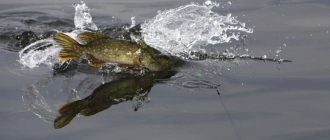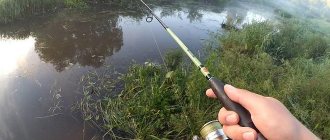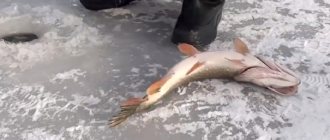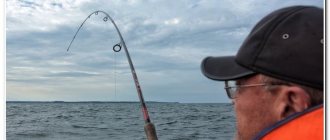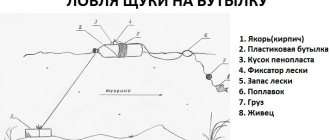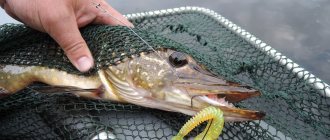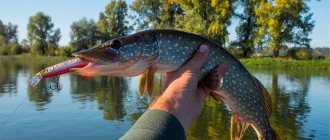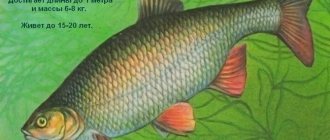To catch pike in the fall using a spinning rod, it is not enough to rely on the zhor and greedy bite of the toothy one. At this time, the predator becomes more active, but this does not mean that it is caught everywhere. With the wrong tactics, equipment leaves the reservoir empty even in the fall, or they catch a couple of small laces.
Hunting for large pike requires more than casting and retrieving, even with the correct spinning equipment. In this article we will look at how to properly catch pike with a spinning rod in the fall, and what baits to use. Let's consider the autumn features of the behavior of the spotted hunter, on which the tactics of searching for and catching a spinning rod are based.
Autumn pike
You can catch a toothy fish with a spinning rod at other times of the year. However, autumn is the best time for this. Autumn pike fishing with a spinning rod is not the only fishing method by which they try to get a toothy one from its native element. All methods work - girders, mugs, live bait fishing rods and other gear. But it is spinning that allows you to quickly explore more possible places and select a working version of bait and wiring.
The main secret to catching pike in any season, including autumn, is understanding the behavior of the toothy pike and adapting to the conditions of the reservoir. It is useless to look for a predator with a spinning rod where it is not found.
Waiting in ambush among underwater vegetation, in snags or in folds of the bottom, the pike looks out for wounded or sick fish, which it grabs without expending much energy. Adult predators eat everything that fits into their mouths - crayfish, leeches, mice, ducklings. Naturally, the basis of the diet is fish. In autumn, pike often leave ambushes, patrolling the adjacent territory in search of prey. Sometimes a strong toothy bite continues for a long time, several hours or a whole day - this condition is called zhor by fishermen.
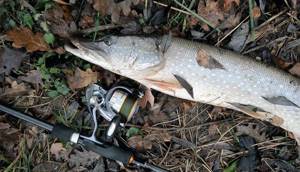
In the fall, pike prepare for winter, and you can catch a lot with a spinning rod if you get to the exit, in the right place at the right time. However, when a fisherman goes to a pond with a spinning rod, the toothy fish does not report whether it will be caught today. Therefore, we get ready for hard fishing, searching and experimenting with baits and games. You can find a pike and catch it with a spinning rod, even if the predator is not feeding at that moment, provoking it into aggression.
More information about the behavioral characteristics of autumn pike: link coming soon
Seasonal features of pike fishing in autumn by month
Features of pike fishing in the fall include changing fishing spots depending on changes in weather conditions. If, with the beginning of the calendar autumn, fishing is carried out on shallows and shallow waters with underwater vegetation, then October fishing shifts to the middle depth levels to the boundaries of dying algae, and November fishing moves to deep-water areas. This dependence is associated with the cooling of water and, as a result, a shift in the food supply of the predator, small carp species of fish, to the zones of underwater pits and its winter moorings. Next, we will take a closer look at the autumn months for fishing conditions for the toothy beauty, tracing the algorithm of the predator’s actions under the influence of external weather factors and its feeding activity.
September
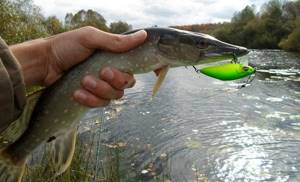
The first half of the month still keeps the predator in underwater thickets, where the grown small fish continue to feed. With cold snaps in the second half of the month, the daily migration of fry begins. Spinning fishing on the river in September moves to the edges, where a predator waits for a passing school of fish and drives it to the shore, the so-called phenomenon among fishermen - washing away small things. In overgrown reservoirs, they continue to fish with poppers and unhooked baits, carried out in the surface layers of the reservoir. In open areas of water they fish with spoons and shallow wobblers. The bite is clearly divided into morning and evening periods, occasionally manifesting itself in short-term fish outings during the daytime.
Important! September fishing is more successful in sunny and clear weather with little wind.
October
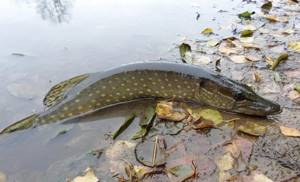
Fishing for pike in October with a spinning rod is especially productive. The pike fattens, entering backwaters, oxbow lakes and rivers, staying close to the fading water banks of dying vegetation, which provided places for its victims to hide. Now the toothy one is characterized by increased aggressiveness and reacts to any active movements that provoke the fish into an immediate attack. Bait placement is carried out at depth differences and slopes from the shallows to the main channels. They are caught using wobblers, spinners of various designs and silicone baits. They don’t skimp on the size of fishing tools; the larger the bait, the higher the likelihood of catching a large fish. They fish bottom and middle water horizons.
Important! The fish bite throughout the daylight hours, and cloudy weather with a south or southwest wind, raising small wave ripples across the surface of the reservoir, is considered the best.
November

Autumn pike fishing with spinning rods shifts to deep waters in November. The established cold weather cooled the water to parameters close to winter conditions and forced all the fish to go deeper into wintering pits. The predator now spins on the edges of such pits, not stopping feeding throughout the day. They continue to fish with wobblers, silicone and oscillating spoons. The bites begin in the late morning and end at dusk.
Important! For hunting, choose days with stable weather, without pressure changes and precipitation. Sunny days are characterized by a large number of bites.
The presence of wind no longer affects the intensity of the bite so much, because fishing is carried out at depths, where the predator is not particularly picky about camouflaging the angler or swimming device, which had an effect when fishing in shallow waters.
When does pike bite on a spinning rod in the fall?
The August activation of pike biting intensifies with the beginning of autumn. However, factors that negatively affect the bite are also increasing - sun and water transparency. When the pike is hungry or going out, it takes a spinning rod without regard to the weather, but you still need to get into such a period. In average conditions, the toothy one does not favor bright lighting, preferring to hide in the shadows of mud and thickets. Pike loves shade, not extreme darkness, but also not clean sandy waters, permeated through with sunlight in clear water.
Every spinning angler knows what weather is best for pike in the fall - cloudy, quiet, with little wind and ripples on the water. In calm conditions, pike take a spinning rod poorly - at this time the background noise in the reservoir is too weak. Toothy prefers to wait out such a period, saving energy. After all, she needs to accumulate reserves, and not burn through them in useless jerks. However, later - in November, when it is already cold, the opposite happens. A quiet, fine sunny day amid a cold and rainy day can provoke a pike to bite.
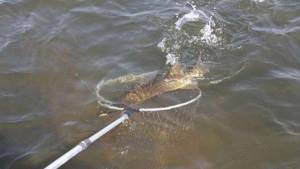
In autumn, the optimal atmospheric pressure for pike is constant, as in other seasons. It doesn't matter whether it's high or low. The main thing is that there are no sharp jumps indicating weather changes. Constant values of the mercury column and thermometer are one of the important factors in the bite of fish, not only predatory ones.
Read more about the right weather for pike in the fall
As the water cools at the end of summer, the situation on the reservoir begins to change. Plankton and suspended algae die off, and underwater vegetation dries out. The fish begin to move, go deeper, and also feed heavily before winter. One of the factors for successful fishing for toothy fish in the fall is monitoring seasonal changes in the reservoir, migration of food and taking this into account in spinning fishing tactics.
Where to look for pike in autumn
Fishing for pike in the fall using spinning rods continues in the places where the predator lives in summer. Areas near the aquatic thickets of the coastal strip and reed walls adjacent to areas of clean water are fished.
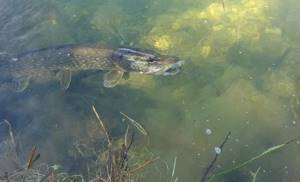
From the moment the intensive death of aquatic vegetation begins, the fish moves behind schools of small fish, which in warm weather come to the shores in the shallows, and on cool and cloudy days they move to the deep-water areas of the reservoir. Under such weather conditions, the predator stands on slopes and edges, waiting for migrating fish. You can catch pike with a spinning rod from the shore in the fall, as in the summer months, focusing on a steep bank, with the current slowing down underneath it. The predator stands at such points all year round. The toothy fish does not leave the snags and bottom bases with driftwood, where it continues to replenish its diet at a more aggressive pace using the ambush method of hunting.
Important! Spinners do not avoid areas near bridges and overpasses. In such structures, areas of underwater areas near the very supports in most cases become a haven for hunting pike.
From boats they fish the edges of the pits, where they manage to catch trophy pike in the fall using a spinning rod, closer to the freeze-up season.
Correct spinning
For spinning pike fishing in the fall, you need to come prepared to the pond. Firstly, if there is no zhora, you need to quickly and effectively use various spinning techniques, baits and wiring methods. Secondly, it is quite likely that a healthy pike, grandma, weighing seven or fifteen kilograms, depending on the area, can land on the hook. The safety margin of the spinning rod and equipment must withstand fishing.
- Most amateur fishermen have tackle for catching pike with a spinning rod in the fall - a regular medium stick with tests depending on the fishing conditions. A regular spinning rod for spinners or a medium jig – 10-30 grams, with a parabolic or semi-fast action, for ponds and medium depths. For large minnow 130 mm wobblers and twitching, you need short, stiff rods with a fast or super-fast action that can pull these stubborn baits through the jerk.
- For heavy jigs on deep riverbeds with current, use more powerful and longer sending catapult spinning rods with weights of up to 50 grams or more. You can also fish with light or ultralight spinning rods - if you are a fan of this particular type of spinning rod. However, for large pike, especially in the fall, you really need a larger caliber.
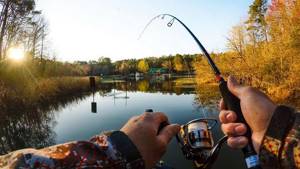
Article about the correct spinning rod for pike
The usual length of a spinning rod is from 2.1 to 3 meters, whichever is more convenient for you. Long spinning rods are more convenient for jigging, and short ones for wobblers. The majority of fishermen are not ready to buy a separate rod for each type of bait. More often, an amateur is looking for one spinning rod with which he can effectively catch different types of bait. However, the range and sensitivity for jigging are difficult to combine with the rigidity and elasticity of a spinning rod for twitching.
If you approach the choice of such a fishing rod correctly, then you can really assemble a universal spinning tackle that can be fished with spinners, wobblers and jigs, without losing the ability to correctly retrieve these baits.
The equipment for pike is usually a braided line 0.12-0.18 mm, 12-30 lb, and a leader made of metal, titanium, Kevlar or fluorocarbon. For wobblers, the string is twisted so that the front tee of the bait does not overlap. Monofilament is almost never used on spinning rods anymore - since braided cord does not stretch, it is thinner at the same breaking load, so it is easier for them to make long, accurate casts and feel contact with the bait.
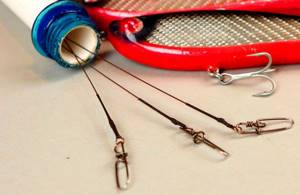
Choosing a place to fish in September
When choosing a place to catch predators, give preference to those bodies of water where they are found - ponds, canals, rivers, lakes and reservoirs.
If we talk about a specific point where it is worth fishing, then it is worth taking into account the behavior of small fish, which are the main food of predators.
Pay attention to the algae near the shore. In such places there is enough food for small fish, which means predators can be caught. However, if the potential food for the “fry” moves away from the shore, then you should not expect a catch in this place.
The habitat of predators at the beginning of September and at the end of the month is different. Fishing in the first half can be based on summer habits, and fishing in the second half should be switched to the autumn-winter period.
Particular attention should be paid to the following places:
— thicket areas;
— bays and oxbows of rivers;
- ducts;
- places where there are many holes and similar shelters at the bottom;
— areas under high banks;
- places with snags and boulders where fish can ambush.
In any case, the fisherman should focus on fishing at the middle level of the reservoir.
Also, the choice of place for fishing depends on what kind of catch you are counting on.
1. If you need catfish or pike perch, then focus on the far edges, not far from holes and snags. It is preferable to fish in the morning or evening. Here it is better to use the jig method.
2. Hunting for perch involves searching for it on the spits and in the surrounding area. It is better to use a rig with a bombard or a retractable leash. For bait, choose small spinners or silicone twisters.
3. You should look for pike in standing reservoirs and inflows of large rivers. More often the fish lives near reeds or water lilies. Fishing is carried out during daylight hours. For bait, focus on minnow wobblers and spinner spoons.
What to use to catch pike in the fall using a spinning rod
Simply put, the best lures for pike in the fall are the usual atom or spoon type oscillators, large wobblers, ratlins, as well as large silicone decoys. However, not everything is so simple.
Sometimes pike take better on small twisters, or, for example, streamers dangling sluggishly in the water. Therefore, you need to be mentally prepared that when fishing with a spinning rod in the fall, everything will not go according to the planned scenario. The most persistent experimenter achieves success in pike fishing, and in the fall as well.
Spinning rod equipment for pike in the fall, during periods of predator activity, needs to be stronger and more reliable, and later – thin, unnoticeable, but at the same time not weak. For example, you can switch to fluorocarbon leashes, but they do not guarantee a successful outcome in the fight against trophy pike. Here it’s better not to reinvent the wheel with various Texas, Carolina or diverting hooks, but to make it more reliable - just a leash with a carabiner and bait. In the case of a jig, use a regular head or hinged mounting of an offset machine on a Cheburashka.
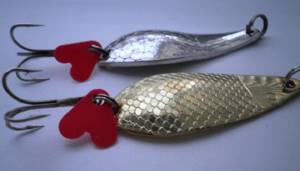
The baits themselves for pike in the fall are discussed in more detail in the article at the link. Let’s take a closer look at the tactical aspects of spinning, their use depending on the conditions of the reservoir and the circumstances during fishing. We will consider two options:
- In a universal medium-caliber spinning rod (most often used by anglers), for fishing in the fall at depths of up to 5 meters, in grass and in calm water.
- The Heavy version includes heavier tackle for heavy jigs, deep wobblers, the use of jerkbaits or swimbaits, silicone from 20 cm or more.
- You can catch spinners with any spinning rod of suitable test - this type of bait is not so demanding on the characteristics of the rod.
Each angler, who in most cases uses one spinning rod, selects baits in a set according to this rod. Therefore, everyone has their own set of baits for autumn pike. Let's look at the general trends in the use of various artificial baits for autumn pike in spinning rods.
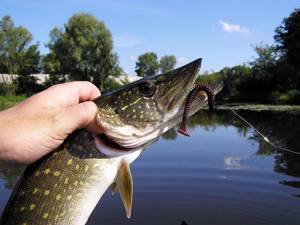
Flashing
Pike on a spinner in the fall is a spinning classic. Before the advent of jigs, wobblers and other modern baits, fishing was done with spoons, atoms, and curtains. The shapes of these classic lures have been selected and perfected on ponds for decades. When asked what kind of spoon to use to catch pike, the Internet produces a bunch of colorful articles where clouds of foreign multi-colored pieces of iron are advertised at exorbitant prices. However, everything is more prosaic. Of all this mass of scrap metal, very few models are actually catchable.
Pike like wide and rare movements of the spoon from side to side. Therefore, not all store-bought fishing irons catch fish - they either have the wrong bend, or the recess in the back is too shallow. It’s better not to chase advertised new products, but to accumulate options that have been proven over the years. In order not to scatter your attention and funds, you need to focus on using several basic spinners in different weights and three basic colors - white (silver), red (copper) and yellow (gold).
Of course, you can catch a toothy one with a castmaster or a spinner, even with offshore jigs plumb from a boat. However, it’s still the autumn theme of pike – the good old spinners. In addition, you don’t need a spinning rod specially tailored for them - as long as it fits the test. Both a jig lover and a wobbler handler can add a few spinners to their arsenal. Sometimes the pike takes only the bait, generally refusing other baits.
Detailed article about lures for pike
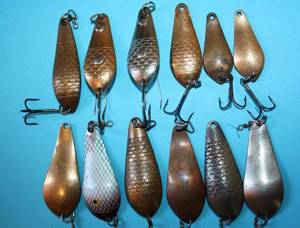
Lures up to 10 grams will be used for light spinning rods, classics 15-25 grams for medium ones, for heavy ones you can find baits for 40 grams, but rarely. The usual standard option is a pair of spinners of each color, for example, Atom-2, Lozhka or Williams Wabler (storling).
Casting a spinning rod for pike in the fall is regular, sometimes intermittent with changes in speed. You need to be able to catch a spoon, not just throw it and pull it. Depth is important, the pause between touching the water and the start of reeling, animation and provocation. Experienced fishermen literally feel the play of the spinner as it moves, feeling it in their hand. If we fish in shallow water, we need to fish high, quickly, and lift the spinning rod up so as not to catch on the grass. At depth, we lower the spoon to the desired horizon, and adjust the stroke height with the speed of the retrieve.
It is better to decorate any spinner with additional elements - red tails made of thread, lurex or store-bought plastic tails. The ideal and practical solution is just red plastic tails. In stores they are sold for a few rubles apiece. Therefore, it is cheaper to order a lot at once from Aliexpress - 100 pieces, enough for a lifetime. The price is ridiculous.
I took it here: https://ali.pub/43u0ye

Wobblers
In autumn, the technique of catching pike with wobblers involves, first of all, twitching. These are already sensational baits such as Rudra, Balisong, Ito Shiner and the like. Each wobbler requires an individual approach using the twitching wiring technique. They are distinguished by their tenacity. One bait can be threaded with a regular spinning rod (ito shiner), while the other will require a stiffer stick (rudra).
It is wobblers that save fishing when the pike is not feeding. Proper twitching (and jerking) causes aggression in the pike, a desire to drive away a competitor or devour him (for the purpose of destruction, not starvation). The price of these baits is no longer a problem, because really catchy replicas of top-end wobblers can be found on Aliexpress at ridiculous prices.
Read more about search and catchable wobblers with aliexpress
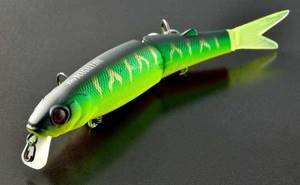
- Despite the high requirements for spinning, more and more amateurs are adapting to twitching large minnows for pike, choosing wisely rods and improving their own technique for working with tackle. Twitching in a pond in the fall is one topic, fishing with deep baits in deep places is another. In addition to twitch, wiring such as ripping, pumping, and jerking is used. Wobblers are a separate sea of knowledge, to which an entire section on our website is dedicated. Read more about the right wobblers for pike
- Easier to master are bladeless wobblers - ratlins, or vibrations, with a mount on the back. Retrieving can be done with any spinning rod, so a novice spinner can fish with them. Including a spinner or a jig lover who doesn’t bother with bladed wobblers and twitching. Rattlin wiring - tightening and releasing the spinning rod, removing the slack. When pulled, the vibrator should flutter and transmit vibration to the hand, which means it works correctly.
- Compound wobblers, such as Magallon and its copies, as well as swimbaits - compound wobblers without a blade in the shape of a fish, also work perfectly on a regular uniform or retrieve with pauses.
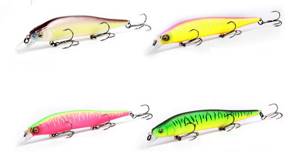
Jig
As already mentioned, jig baits for pike in the fall need relatively large ones - in most cases. However, you should not discount the little things, especially at the end of autumn, when the pike is passive. We focus on large sizes - vibrating tails or twisters 5-6 inches (from 12 cm), but if it doesn’t work, we also check small silicones.
By color - we check dark natural tones (brown, purple, machine oil) and bright ones (orange, yellow, acid green). You need to experiment in this matter, especially in November, when the pike may not show itself right away.
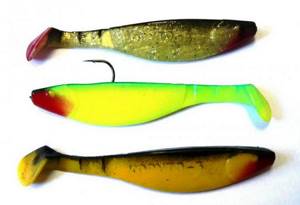
If at the beginning of autumn the spinning rod requires a more aggressive, bright retrieve, then in November it requires a slow, careful one. For passive biting on a spinning rod in the pre-winter period, a drop shot and twitching on the spot may work better. However, it needs to be knitted on metal to protect it from pike teeth. You can also check the Carolina or Texas pike versions, when the rig is located on a metal leash, and not on a cord or fishing line. It is impossible to correctly jig for pike in the fall according to a single recipe - an experimental approach is important, as elsewhere.
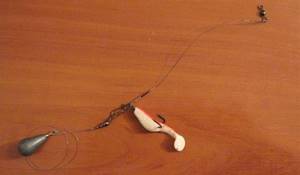
Streamers
When it doesn’t take at all, especially before winter, streamers - heavy, large, weighted flies - can help out. Not many people catch this bait with a spinning rod, however, successfully. A pike streamer is needed not like in fly fishing, but the right one, for a spinning rod - large, with natural or synthetic fur or feathers, with a weight that allows you to cast it. It is difficult to find such bait in stores, but you can make it yourself from scrap materials. The streamer is mounted on a jig head for retrieving from the bottom or directly to the leash for twitching above the thickets.
Large pike are often caught by such deception, refusing to take the usual baits, which already pass under their noses a dozen times a day. It can be difficult to provoke a pike to bite, even in the fall, in places constantly visited by spinning anglers.

Unhooked baits and other spinning baits
Don’t forget to check the grass and shallow waters, or pull surface baits from the reed wall towards you – especially in early autumn, when it’s still warm. Here you need summer poppers, sticks (walkers), Croatian eggs, silicone ducklings (frogs, mice) or just an unloaded jig, spinners with a regular hook and an anti-snap wire.
Fishing for pike on the river in the fall often involves checking the entrances and exits of holes and rapids full of reeds, algae or mud. In such conditions, it is advisable to use spinnerbaits that pass through rare soft mud well without snagging thanks to the silicone brush on the hook. However, this bait is more likely for an active pike, which is not able to miss an incomprehensible redfish swimming nearby. Fishing for pike with a spinnerbait in the fall is more effective at the beginning of the season, when fishing with a spinning rod in shallow and medium depths with thickets.
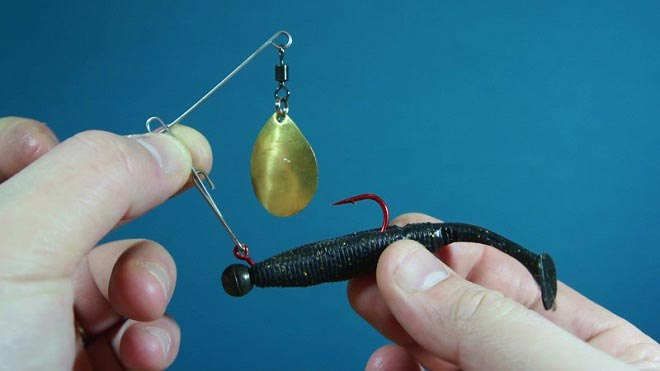
We catch pike at the end of August
At the end of August, the water temperature began to drop slightly, almost imperceptibly, but the fish feel it. And the pike in the fall, once lethargic from the heat, slowly returns to life. Predator bites are observed more and more often, and the place of fishing is shallows, along the grass, holes, exits from holes . Near old bridges, behind islands, which are not so rare on small rivers. All fish are active at this time, and the fry still stays in the coastal zone, attracting predators. As for baits , the choice is huge, and there is no point in describing everything. I’ll put it simply: “The more diverse your baits are, the more of them, the better, since you have endless possibilities for experimentation.” I usually do this: I fish for 10-15 minutes on one of the baits, changing the wiring, and if there is no bite, I put on another spoon or wobbler. Thus, in 1-2 hours you can understand which tackle is currently more attractive for pike fishing.
Search tactics and fishing techniques
Fishing for pike with a spinning rod in the fall from the shore is different from fishing from a boat. A small overgrown river requires one tactic, a wide reservoir another. Also, adjustments are made by the weather and the behavior of the predator on a particular body of water. Therefore, there is no single recipe for search and tactical actions for spinning - we work according to the situation.
- On the small river we go around promising points - the principle here is that the more you go, the better, especially in September. Only at the end of autumn, in especially promising places that are obviously catchy, does it make sense to fish these waters more carefully, experimenting with baits and their game.
- On the lake, you should also look for pike in the fall with a spinning rod, focusing on external landmarks - a break in the shore, fallen trees, reeds and islands of thickets. Large bodies of water without external landmarks are more difficult to study - you will need an echo sounder or at least measuring the depth with a jig step.
- In any case, you should not throw the bait at the first place you come across - you need to look for points, by boat or on foot. All spinning pike fishing is based on searching and choosing the right place - this fish lives in certain places, and not everywhere.
- In any body of water, a floating device increases the capabilities of a spinning player. To cast a spinning rod, distant edges, blind windows, thickets and other hard-to-reach places that cannot be reached from the shore are opened. And these are the kind of spots that pike loves. And the consumption of baits due to snags on trees and bushes is several times less - you just swim up and unhook. On large bodies of water and densely overgrown ponds along the banks, you can’t go anywhere without a boat. Now organizing a boat for yourself is not a problem. The simplest single-seat bag, which you can take with you in a backpack, weighs 7-8 kg and costs no more than 8 thousand.
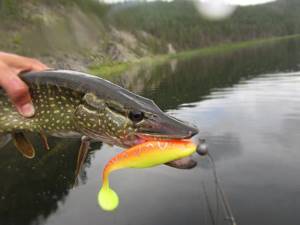
Fishing for pike with live bait
The best places for such fishing are lakes and bays with standing water. Predators are caught using live fish using live bait rods, bottom gear, girders, circles, and nets. To install the last three you will need a boat. It is advisable to use live bait from the same reservoir where fishing will take place. It is important that they are active, mobile, and clearly visible in the water. That is, attractive to a predator. The fish will remain like this for a long time if you insert it through the nostril or pierce it under the dorsal fin.
Advice for beginners
In autumn, pike have the longest meal. To catch her at this time, it is not at all necessary to have a lot of experience and super skills. It is enough to glean a little information from fishing sources, get a couple of tips from experienced fishermen, decide on the fishing method, and you can safely go after your first pike. It is quite possible that not alone.
How to catch a large pike in the fall
For every spinning angler, pike fishing is a search for a large seasoned predator, from three kg. With the right approach using a spinning rod, it is quite possible to catch such pike, including in urbanized regions of the middle zone. If you constantly hammer the coastal grass with small baits, then the catch will mostly contain strings.
Rules for large pike on spinning rods in the fall:
- Real pike matrons live closer to the depths, on riverbanks or in snags. Interesting are the sharp changes, the confluence of tributaries, and local anomalies in deep backwaters. Only in completely overgrown, relatively shallow water areas can a large pike be found among the grass. But if in such a pond there is a depth extending down from the reed wall, then sooner or later by winter the mother will definitely come to this deeper place.
- To purposefully catch a trophy predator, you need, at a minimum, to set yourself such a goal. There is absolutely no point in hammering one point in the hope of a big one, if there is no trace of it there. You need to deliberately look for crocodiles, and not rely on luck. And be patient while doing so. In really catchy places, you need to spend more time fishing the point, try different wiring and bait. It is difficult to persuade a pike under ten - most likely, it is already familiar with anglers and spinning rods firsthand.
- Pike wants to eat in the fall, but in clear water it becomes more attentive. To catch a trophy, several factors must come together, plus luck. Large pike react more painfully to weather changes and migrate differently due to seasonal fluctuations. And if the laces are caught, it is not a fact that their grandmother will also be active.
- In the fall, on the river, where small fish are usually caught, you can also snatch a trophy - but for this you need to be patient. We go and check promising points with a spinning rod - sooner or later, perhaps the only matron of the local waters will show herself - before winter she needs to eat much more than the grass, since a lot of caviar is ripening in her belly.
- The closer you get to winter, the larger the bait you need to use on a spinning rod and cast it more slowly, taking longer pauses. Large vibrating tails and twisters, spoons, 130 wobblers are our everything. However, don’t forget to check small baits – who knows. This year I took out a 7400 mother on a 7 cm twister when fishing for perch. The best weather for large fish is classic pike weather, when cool temperatures, cloudiness and a light breeze last for several days in a row without sudden changes.
- When equipping a spinning rod, you need to pay due attention to the fittings so that it does not fail at a crucial moment. If there are no reliable swivels and fasteners, we knit on a knotless string. And forget about fluorocarbon - only reliable long metal leashes, preferably long ones - up to 40 cm. If there is no suitable length, you can put two in series.
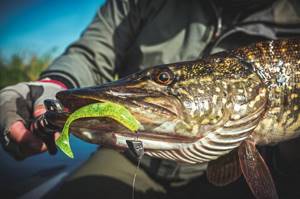
Basic fishing for pike in autumn
The list of basic and popular ones includes uniform, twitching or jerking, ripping, aggressive, demolition or jumping. Each variety is characterized by a special execution technique.
How to do wiring correctly
| Name | Peculiarities |
| Uniform | Ineffective for pike. There are no active movements, wiring does not attract pike. Used to catch other white predators. |
| Twitching, jerking |
The technique consists of light and smooth movements of the spinning rod horizontally. |
| Riping | The rod is moved in a top-down direction. The advantage of this method is deeper penetration of the bait. |
| Aggressive | The jerks resemble hooking, the bait imitates a fish that is trying to swim away quickly, then returns to its original position with oscillating movements. |
| For demolition | The wiring is carried away by the current. It is important to choose the right weight of the bait so that it does not float up and plow the bottom. |
| Jumping | Jumping movements - sharp twitching of the spinning rod, during which the bait comes off by 5-10 cm. |
Fishing tactics
On small bodies of water, as already mentioned, when fishing from the shore you need to walk and search a lot. Opportunities here are limited by approaches to the shore. Therefore, it is better not to use original wobblers for 2000 rubles in difficult places. For spinning on small rivers for pike in the fall from the shore, more jigs, spinners or surface baits are used.
If you catch pike from a boat in the fall, or in any other season, the possibilities of an angler with a spinning rod expand significantly. However, another problem arises - disorientation amid great fishing opportunities. What to use, jig or wobblers, where to swim in large water areas?
You need to create a plan in your head and stick to it. For example, devote part of your time to exploring the depths, then fire at the edge with wobblers or jigs. If he doesn’t take it, walk through the surrounding bushes, and in the evening return to the depths again and check the riverbed.
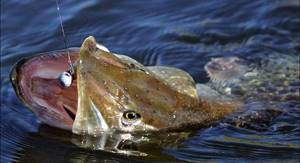
On reservoirs with a pronounced channel and relief in cold water, there are few options - we look for anomalies on the bottom, snags, dumps, areas with grass among the sandy bottom, and fish. Large pike will already be here in late autumn, even if they were previously standing somewhere in the coastal reeds. Accordingly, at the beginning of September it is necessary to check the coastal bushes.
On large rivers, such as the Don, Volga, Ob, near the banks there are quite deep places with debris of driftwood - naturally, such places need to be fished first. Here, due to the strong current and the high probability of snags, it is better to work with a heavy jig. If it doesn’t take you, you don’t need to get hung up on one bait or its wiring. It is important to experiment with spinning and look for a working option today.
Subscribe to the channel:
YouTube channel RYBAFAN
We are VKontakte
Types of spinning fishing in September
In September, the fish stops resting in one place. She begins to walk around the pond and sink to the bottom more often. And despite the fact that the fish are just beginning to change behavior, the bite can be inconsistent. This is due to weather conditions, atmospheric pressure and similar factors.
According to summer habits, the catch can be good only in early September, when the algae have not yet become shallow, and pike, perch or pike perch can be caught in shallow water and even near the surface.
The activity of the predator remains the same, according to the summer regime: morning and evening. However, temperature changes cause a change in the nature of the inhabitants of reservoirs. Towards the end of the month, the fish become lethargic.
Therefore, you should take into account the peculiarities of fishing both from the shore and from a boat.
